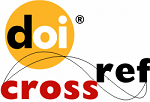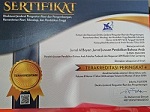Innovation in Authentic Assessment of Maharah Qira’ah in the Textbook of Al-’Arabiyyah Baina Yadaik Volume II
Abstract
Keywords
References
Abdullah, R. “Urgensi Penilaian Hasil Belajar Berbasis Kelas Mata Pelajaran IPS Di Madrasah Tsanawiyah.” Lantanida Journal 3, no. 2 (2017). https://doi.org/https://doi.org/10.22373/lj.v3i2.1657.
Afflerbach, Peter, P. David Pearson, and Scott G. Paris. “Clarifying Differences Between Reading Skills and Reading Strategies.” The Reading Teacher 61, no. 5 (2018): 364–73.
Baharun, H. “Penilaian Berbasis Kelas Pada Pembelajaran Pendidikan Agama Islam Di Madrasah.” MODELING: Jurnal Program Studi PGMI 3, no. 2 (2016).
Baroroh, R. U, and F. N Rahmawati. “Metode-Metode Dalam Pembelajaran Keterampilan Bahasa Arab Reseptif.” Urwatul Wutsqo: Jurnal Studi Kependidikan Dan Keislaman 9, no. 2 (2020): 179–96. https://doi.org/https://doi.org/10.54437/urwatulwutsqo.v9i2.181.
Djumingin, Sulastriningsih, and Sukardi Weda Juanda. “Anxiety in Classroom Presentation in Teaching-Learning Interaction in English for Students of Indonesian Study Program at Higher Education.” International Journal of Education and Practice 7, no. 1 (2019): 1–9.
Firdaus, H, A. M Laensandi, G Matvayodha, F. N Siagian, and I. A Hasanah. “Analisis Evaluasi Program Kurikulum 2013 Dan Kurikulum Merdeka.” Jurnal Pendidikan Dan Konseling (JPDK) 4, no. 4 (2022).
Fisher, Douglas, and Nancy Frey. Improving Adolescent Literacy: Content Area Strategies at Work. London: Pearson Education, 2017.
Hanip, Adam Rusdam, Ahmad, and Akhmad Alim. “Analisis Buku Ajar Al-’arabiyyah Baina Yadaik Jilid II.” Al-Mi’yar: Jurnal Ilmiah Pembelajaran Bahasa Arab Dan Kebahasaaraban 6, no. 2 (2023): 789–814.
Hardiyanto, F. E. “Model Penilaian Produktif Mata Kuliah Menulis Berbasis Nilai Humanis.” Jurnal Pendidikan Bahasa Dan Sastra Indonesia 9, no. 1 (2020). https://doi.org/https://doi.org/10.15294/jpbsi.v9i1.38686.
Hattie, John, and Gregory Yates. Visible Learning and the Science of How We Learn. Routlegde, 2013.
Hekmah, N, I Wilujeng, and I. G. P Suryadarma. “Web-Lembar Kerja Siswa IPA Terintegrasi Lingkungan Untuk Meningkatkan Literasi Lingkungan Siswa.” Jurnal Inovasi Pendidikan IPA 5, no. 2 (2019). https://doi.org/https://doi.org/10.21831/jipi.v5i2.25402.
Hidayat, W, and A Andriani. “Pelaksanaan Penilaian Autentik Guru Pendidikan Anak Usia Dini.” Cakrawala Dini: Jurnal Pendidikan Anak Usia Dini 11, no. 2 (2020). https://doi.org/https://doi.org/10.17509/cd.v11i2.24922.
Jones, Michael, and Sarah Lee. “Implementing Authentic Assessment in the Classroom.” Teaching and Teacher Education 21, no. 8 (2005): 859–72.
Julaeha, S. “Problematika Kurikulum Dan Pembelajaran Pendidikan Karakter.” Jurnal Penelitian Pendidikan Islam 7, no. 2 (2019). https://doi.org/https://doi.org/10.36667/jppi.v7i2.367.
Morrow, Lesley Mandel. Literacy Development in the Early Years: Helping Children Read and Write. London: Pearson Education, 2015.
Munip, A. “Penilaian Pembelajaran Bahasa Arab.” Fakultas Ilmu Tarbiyah Dan Keguruan UIN Sunan Kalijaga, 2017.
Munir, Acep, and Abdul Wahab Rosyidi. Al-’Arabiyyah Baina Yadaik: An Intermediate Course in Arabic. Vol. 2. Jakarta: Pusat Bahasa, 2008.
Musfiqon. Penilaian Otentik Dalam Pembelajaran Kurikulum 2013. Sidoarjo: Nizamia Learning Center, 2016.
Nurgiyantoro, Burhan. Penilaian Otentik Dalam Pembelajaran Bahasa. Yogyakarta: Gadjah Mada University Press, 2015.
Pradita, L. E, R Jayanti, A. Endriyanti Mardliyah, and E Suwandana. “Berbahasa Produktif Melalui Keterampilan Berbicara: Teori Dan Aplikasi.” PT Nasya Expanding Management, 2021.
Setiawan, A. R. “Instrumen Penilaian Untuk Pembelajaran Ekologi Berorientasi Literasi Saintifik.” Assimilation: Indonesian Journal of Biology Education 2, no. 2 (2019). https://doi.org/https://doi.org/10.17509/aijbe.v2i2.19250.
Shanahan, Timothy. Relationships Between Reading and Writing Development. Erlbaum: Lawrence Erlbaum Associates, 2021.
Simin, Febriati, and Yusuf Jafar. “Meningkatkan Kemampuan Menceritakan Kembali Isi Bacaan Melalui Pendekatan Komunikatif Pada Siswa Kelas IV Di SDN 1 Limboto Barat Kabupaten Gorontalo.” AKSARA: Jurnal Ilmu Pendidikan Nonformal 04, no. 03 (2018): 209–16.
Smith, Jane. “The Benefits of Authentic Assessment in the Classroom.” Educational Leadership 67, no. 4 (2010): 30–34.
Smith, John. “The Importance of Authentic Assessment in Education.” Journal of Educational Research 25, no. 3 (2018): 45–57.
Smith, Lisa, and James Wong. “Authentic Assessment: Putting Theory into Practice.” Clearing House 79, no. 6 (2021): 264–69.
Subyantoro. Pembelajaran Bercerita: Model Bercerita Untuk Meningkatkan Kepekaan Emosi Dalam Berapresiasi Sastra. Yogyakarta: Ombak, 2013.
Sugiri, W. A, and S Priatmoko. “Perspektif Asesmen Autentik Sebagai Alat Evaluasi Dalam Merdeka Belajar.” At-Thullab: Jurnal Pendidikan Guru Madrasah Ibtidaiyah 4, no. 1 (2020). https://doi.org/https://doi.org/10.30736/atl.v4i1.119.
Supriyono, S. “Aplikasi Penilaian Berbasis Kelas Dalam Pembelajaran Bahasa Indonesia.” INSANIA: Jurnal Pemikiran Alternatif Kependidikan 24, no. 2 (2019). https://doi.org/https://doi.org/10.24090/insania.v24i2.2832.
Tompkins, Gail E. Literacy for the 21st Century: A Balanced Approach. 6th ed. London: Pearson Education, 2013.
Torgesen, Joseph K. “The Prevention of Reading Difficulties.” Journal of School Psychology 40, no. 1 (2021): 7--26.
Widasari, Rahayu Hardini. “Hubungan Penguasaan Kosakata Dengan Keterampilan Bercerita Siswa Kelas v SD Negeri Sekecamatan Wonosari Kabupaten Gunung Kidul.” Skripsi: Universitas Negeri Yogyakarta., 2012.
Widiana, I. G. K, N Dantes, and D. P Pramiti. “Pengembangan Instrumen Penilaian Kognitif Pembelajaran Tematik Tema 8 Subtema 1 Pada Siswa Kelas v SD.” Jurnal Ilmiah Pendidikan Profesi Guru 3, no. 3 (2020). https://doi.org/http://repo.undiksha.ac.id/id/eprint/4630.
Wiggins, Grant, and Jay McTighe. Understanding by Design. Pearson, 2022.
Wildan, W. “Pelaksanaan Penilaian Autentuk Asppek Pengetahuan, Sikap Dan Keterampilan Di Sekolah Atau Madrasah.” Jurnal Tatsqif 15, no. 2 (2017). https://doi.org/https://doi.org/10.20414/jtq.v15i2.3.
DOI: http://dx.doi.org/10.24042/albayan.v17i1.24681
Refbacks
- There are currently no refbacks.
Copyright (c) 2025 Jurnal Al Bayan: Jurnal Jurusan Pendidikan Bahasa Arab
License URL: https://creativecommons.org/licenses/by-nc-sa/4.0
Editorial Office:
Jurnal Al Bayan: Jurnal Jurusan Pendidikan Bahasa Arab, Arabic Education Study Program, Faculty of Education and Teachers Training, Unversitas Islam Negeri Raden Intan Lampung
Jl. Endro Suratmin 1 Sukarame, Bandar Lampung 35131-Indonesia
e-mail: jurnalalbayan@radenintan.ac.id
http://ejournal.radenintan.ac.id/index.php/albayan/index
Jurnal Al Bayan: Jurnal Jurusan Pendidikan Bahasa Arab is licensed under a Creative Commons Attribution-ShareAlike 4.0 International License. p-ISSN 2086-9282 | e-ISSN 2549-1229









